| Latest | Greatest | Lobby | Journals | Search | Options | Help | Login |
|
|
|
This topic is archived. |
| Home » Discuss » Topic Forums » Sports |
|
| Jack Rabbit
|
Sat Apr-24-10 12:04 AM Original message |
| The JR Chess Report (April 23): Championship Match Starts Tomorrow |
|
Anand-Topalov Title Match begins tomorrow
 The 12-round match for the world title between reigning champion Vishy Anand of India and Bulgarian GM Veselin Topalov, who was the last of the FIDE champions that began in the schism that pitted Garry Kasparov against FIDE, begins tomorrow (Saturday) in the Bulgarian capital of Sofia. The match will last until Tuesday, May 11, when the final round is played, with any necessary tiebreaks sceduled for May 13. The match was originally scheduled to begin today, but was postponed for one day due to the difficulties the champion had in making arrangments for travel in the wake of the eruption of the volcano Eyjafjallajökul in Iceland. Anand, his wife and business manager, Aruna, and two assistants arrived in Sofia Tuesday morning after traveling from Frankfurt, where Anand and his entourage were stranded last week, to Sofia by car for 40 hours. The Irish-based online betting website PaddyPower has made Anand a 4/9 favorite to win the match. Games will be broadcast live on the Official match website. All games begin at 3 pm Eastern European Standard Time (5 am PST). Ninth Asian Championships underway in the Philippines  The ninth annual Asian Championships began Wednesday in Subic Bay, the Philippines. The competition is divided into two groups: the general group with 90 participants and the women's group with 24 competitors. After three rounds in the general group, 16-year-old Wesley So of the Philippines, Yu Yangyi of China and Indonesian GM Magaranto Susanto are tied for first place with perfect scores. In the women's group, Wang Yu of China is the only play with a perfect score after three rounds. Both groups will play 11 rounds and finish April 30. Other tournments starting this week: Women's Grand Prix, Nalchik 23 April-6 May. Calendar Bosna 2010, Sarajevo 5-14 May. Grand Prix, Astrakhan (Russia) 9-25 May. US Championship, St. Louis 13-25 May. Chicago Open 27-31 May. Karpov Tournament, Poikovsky 31 May-14 June. Bacrot, Bologan, Jakovenko, Motylev, Onischuk, Rianzantsev, Rublevsky, Shirov, Ivan Sokolov, Sutivsky, Svidler and Wang Hao. 45th Capablanca Memorial Tournament, Havana 9-22 June. Alekseev, Bruzón, Domínguez, Ivanchuk, Nepomniachtchi and Short. Kings Tournament, Banza 14-24 June. Carlsen, Gelfand, Nisipeanu, Ponomariov, Radjabov and Wang Yue. Women's Grand Prix, Jermuk 23 June-6 July. World Open, Valley Forge, Pennsylvania 29 June-5 July. Sparkassen Chess Meeting, Dortmund 15-25 July. Kramnik, Le Quang Liem, Leko, Mamedyarov, Naiditsch and Ponomariov. Women's Grand Prix, Ulan Bator (Mongolia) 29 July-12 August. World Junior Championships, Chotowa Czarna (Poland) 2-17 August. Mainz Chess Classic 6-8 August. The world economic crisis reduces the festival to three days in 2010, with the rapid open and simultaneous exhibitions by Vishy Anand and Alexandra Kosteniuk being the only featured events. Chess Olympiad, Khanty Mansiysk 19 September-4 October. Pan-American Women's Championship, São Paulo 10-21 October. European Club Cup, Plovdiv 16-24 October. Women's Grand Prix, Vina del Mar (Chile) 27 October-9 November. World Youth Championships, Halidiki (Greece) 19-31 October. FIDE Women's Knock Out (Women's World Championship), Turkey 2-25 December. |
| Printer Friendly | Permalink | | Top |
| Jack Rabbit
|
Sat Apr-24-10 12:06 AM Response to Original message |
| 1. This Week's Games |
|
Your humble hare acknowledges the assistance of Fritz 6.0 on analysis. Diagrams on the Jack Rabbit Chess Report are made with Chess Mérida, a true type font that can be downloaded free here. !""""""""# $tMvWlVmT% $OoOoOoOo% $ + + + +% $+ + + + % $ + + + +% $+ + + + % $pPpPpPpP% $RnBqKbNr% /(((((((() WHITE White to move (This position is a theoretical draw) I would like to thank my impressive and loyal staff: Buccaneer, Spitfire, Swashbuckler, Pancho and Robin Hood. |
| Printer Friendly | Permalink | | Top |
| Jack Rabbit
|
Sat Apr-24-10 12:07 AM Response to Reply #1 |
| 2. Ninth Asian Championships, Subic Bay |
| Printer Friendly | Permalink | | Top |
| Jack Rabbit
|
Sat Apr-24-10 12:08 AM Response to Reply #2 |
| 3. Salem - So, General Group, Round 2 |
|
Edited on Sat Apr-24-10 12:11 AM by Jack Rabbit
 Wesley So Saleh Salem - Wesley So Ninth Asian Championships (General Group), Round 2 Subic Bay, 22 April 2010 West India Game: Indian Queen's Gambit (Goglidze Opening) (Grünfeld Defense) 1.d4 Nf6 2.c4 g6 3.f3
3...d5 4.cxd5 Nxd5 5.e4 Nb6 6.Nc3 Bg7 7.Be3 0-0 8.Qd2
8...Nc6 9.0-0-0 f5
10.e5 Nb4 11.Nh3
11...Be6 12.Kb1 Qd7
13.Nf4 Bf7 14.h4!?
14...Rfd8
15.Bb5!?
15...c6
16.Be2 c5!?
17.e6!?
17...Bxe6 18.dxc5 Bxc3 19.bxc3 !""""""""# $t+ T +l+% $Oo+wO +o% $ M +v+o+% $+ P +o+ % $ M + N P% $+ P Bp+ % $p+ Qb+p+% $+k+r+ +r% /(((((((() WHITE: Saleh Salem Position after 19.bc3:B 19...Qa4!?
20.Qxd8+
20...Rxd8 21.Rxd8+ Kf7 22.Rf8+!?
22...Kxf8 23.Nxe6+ Kg8!?
24.cxb4
24...Qxb4+ 25.Kc2 !""""""""# $ + + +l+% $Oo+ O +o% $ M +n+o+% $+ P +o+ % $ W + + P% $+ + Bp+ % $p+k+b+p+% $+ + + +r% /(((((((() WHITE: Saleh Salem Position after 25.Kb1c2 25...Nd5!?
26.Bd2 Qa4+ 27.Kb2
27...Nb4 28.Bxb4
28...Qxb4+ 29.Kc2 Kf7
30.Ng5+ Kg7 31.Kd3?
!""""""""# $ + + + +% $Oo+ O Lo% $ + + +o+% $+ P +oN % $ W + + P% $+ +k+p+ % $p+ +b+p+% $+ + + +r% /(((((((() WHITE: Saleh Salem Position after 31.Kc2d3 31...Qa3+! 32.Kd4
32...Qxa2 33.Bc4
33...Qd2+ 34.Ke5
34...Qc3+ 35.Kd5 h6 36.Ne6+
36...Kf6 37.Nd4 e6+! 0-1
|
| Printer Friendly | Permalink | | Top |
| Jack Rabbit
|
Sat Apr-24-10 12:10 AM Response to Reply #2 |
| 4. Bernales - Sukandar, Women's Group, Round 1 |
|
Irine Kharisma Sukandar, 18, is Indonesia's strongest woman chess master.
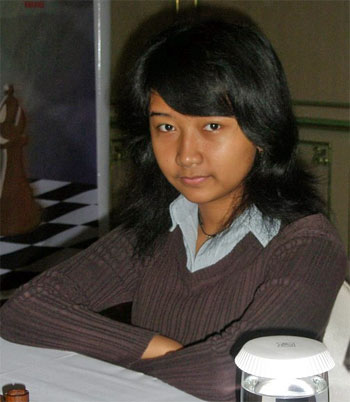 Irine Kharisma Sukandar Christy Bernales - Irine Kharisma Sukandar Ninth Asian Championships (Women's Group), Round 1 Subic Bay, 21 April 2010 Closed Sicilian Game: Grand Prix Opening 1.e4 c5 2.Nc3 Nc6 3.f4 g6 4.Nf3 Bg7 5.Bb5
5...Nd4 6.0-0 a6
7.Bc4 e6
8.Nxd4!?
8...cxd4
9.Ne2 Ne7 10.Bb3 0-0 11.d3 d6 12.Ng3
12...Kh8
13.Kh1 f5 14.Qe2 Bd7 15.Bd2
15...Qb6 16.Rae1 Rae8 17.exf5
17...exf5 18.Qf2 Bc6
19.Re6 Nd5 20.Rfe1 !""""""""# $ + +tT L% $+o+ + Vo% $pWvOr+o+% $+ +m+o+ % $ + O P +% $+b+p+ N % $pPpB QpP% $+ + R +k% /(((((((() WHITE: Christy Bernales Position after 20.Rf1e1 20...Ne3!?
21.Bxe3?!
21...Rxe6 22.Bxe6 dxe3 23.Qxe3 Qxb2 24.Bb3 Bf6!?
25.Ne2
25...Re8 26.Qg1!?
26...Kg7 27.Rb1? !""""""""# $ + +t+ +% $+o+ + Lo% $o+vO Vo+% $+ + +o+ % $ + + P +% $+b+p+ + % $pWp+n+pP% $+r+ + Qk% /(((((((() WHITE: Christy Bernales Position after 27.Re1b1
27...Qxb1!!
28.Qxb1 Rxe2 29.Qf1 Rd2 30.Qg1 Kh6!
31.h3 Bh4 32.Kh2 Rf2 33.a3
33...Kg7 34.c3 h6 35.Be6
35...Kf6 36.Bg8 g5 37.fxg5+ hxg5 38.c4 !""""""""# $ + + +b+% $+o+ + + % $o+vO L +% $+ + +oO % $ +p+ + V% $P +p+ +p% $ + + TpK% $+ + + Q % /(((((((() WHITE: Christy Bernales Position after 38.c3c4 38...f4!
39.Bd5 Bg3+ 40.Kh1 Bxd5 41.cxd5 Re2 0-1
|
| Printer Friendly | Permalink | | Top |
| Jack Rabbit
|
Sat Apr-24-10 02:02 AM Response to Original message |
| 5. Bonus Games: World Championship III: Karpov and Kasparpv, the Schism and the Present |
 Reigning world champion Vishy Anand (center) flanked by former champions Garry Kasporov and Anatoly Karpov |
| Printer Friendly | Permalink | | Top |
| Jack Rabbit
|
Sat Apr-24-10 02:03 AM Response to Reply #5 |
| 6. Karpov - Kasparov, Round 9, Moscow, 1984 |
|
Anatoly Karpov became world champion in 1975 when Bobby Fischer declined to defend his title. To demonstrate his worthiness, Karpov spent the next three years participating in and winning a number of strong tournaments.
He lost the title in 1985 to Garry Kasparov, then only 22 years old. Between 1984 and 1990, the two fought a total of five matches for the world championship which generated some of the greatest chess ever.  Anatoly Karpov Anatoly Karpov - Garry Kasparov Match for the World Title, Round 9 Moscow, 5 October 1984 Orthodox Queen's Gambit: Normal Defense (Tarrasch Defense) 1.d4 d5 2.c4 e6 3.Nf3 c5
4.cxd5 exd5 5.g3
5...Nf6 6.Bg2 Be7 7.0-0 0-0 8.Nc3 Nc6 9.Bg5
9...cxd4
10.Nxd4 h6 11.Be3 Re8 12.Qb3
12...Na5 13.Qc2 Bg4 14.Nf5
14...Rc8
15.Bd4
15...Bc5 16.Bxc5
16...Rxc5 17.Ne3 Be6 18.Rad1
18...Qc8 19.Qa4 Rd8 20.Rd3 a6 21.Rfd1 Nc4 22.Nxc4 Rxc4 23.Qa5 Rc5!?
!""""""""# $ +wT +l+% $+o+ +oO % $o+ +vM O% $Q To+ + % $ + + + +% $+ Nr+ P % $pP +pPvP% $+ +r+ K % /(((((((() WHITE: Anatoly Karpov Position after 23...Rc4c5 24.Qb6
24...Rd7 25.Rd4
25...Qc7 26.Qxc7 Rdxc7 27.h3!
!""""""""# $ + + +l+% $+oT +oO % $o+ +vM O% $+ To+ + % $ + R + +% $+ N + Pp% $pP +pPb+% $+ +r+ K % /(((((((() WHITE: Anatoly Karpov Position after 27.h2h3 27...h5!
28.a3 g6 29.e3 Kg7 30.Kh2
30...Rc4 31.Bf3
31...b5 32.Kg2 R7c5! 33.Rxc4
33...Rxc4 34.Rd4!?
!""""""""# $ + + + +% $+ + +oL % $o+ +vMo+% $+o+o+ +o% $ +tR + +% $P N PvPp% $ P + Pk+% $+ + + + % /(((((((() WHITE: Anatoly Karpov Position after 34.Rc4d4 34...Kf8!
35.Be2!
35...Rxd4!?
36.exd4 Ke7 37.Na2 Bc8 38.Nb4 Kd6
!""""""""# $ +v+ + +% $+ + +o+ % $o+ L Mo+% $+o+o+ +o% $ N P + +% $P + + Pp% $ P +bPk+% $+ + + + % /(((((((() WHITE: Anatoly Karpov Position after 38.Ke7d6 39.f3 Ng8 40.h4
40...Nh6 41.Kf2 Nf5 42.Nc2 f6 43.Bd3 g5 44.Bxf5 Bxf5
45.Ne3 Bb1 46.b4 gxh4
47.Ng2
47...hxg3+ 48.Kxg3 Ke6 49.Nf4+ Kf5 50.Nxh5
50...Ke6 51.Nf4+ Kd6 52.Kg4
52...Bc2?
!""""""""# $ + + + +% $+ + + + % $o+ L O +% $+o+o+ + % $ P P Nk+% $P + +p+ % $ +v+ + +% $+ + + + % /(((((((() WHITE: Anatoly Karpov Position after 52...Bb1c2 53.Kh5!
53...Bd1
54.Kg6 Ke7
55.Nxd5+!
55...Ke6
56.Nc7+!
56...Kd7 57.Nxa6 Bxf3 58.Kxf6 Kd6 59.Kf5
59...Kd5 60.Kf4 Bh1 61.Ke3 Kc4
62.Nc5 Bc6 63.Nd3 Bg2 64.Ne5+ Kc3
65.Ng6 Kc4
66.Ne7 Bb7 !""""""""# $ + + + +% $+v+ N + % $ + + + +% $+o+ + + % $ PlP + +% $P + K + % $ + + + +% $+ + + + % /(((((((() WHITE: Anatoly Karpov Position after 66...Bg2b7 67.Nf5!
67...Bg2
68.Nd6+ Kb3 69.Nxb5 Ka4 70.Nd6 1-0
|
| Printer Friendly | Permalink | | Top |
| Jack Rabbit
|
Sat Apr-24-10 02:05 AM Response to Reply #5 |
| 7. Karpov - Kasparov, Round 16, Moscow, 1985 |
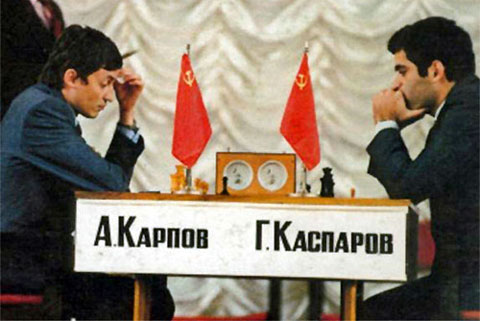 Anatoly Karpov and Garry Kasparov palyed five matches for the world title from 1984 through 1990 Anatoly Karpov - Garry Kasparov Match for the World Title, Round 16 Moscow, 15 October 1985 Open Sicilian Game: Taimanov Defense (Szen Opening/Kasparov Gambit) 1.e4 c5 2.Nf3 e6 3.d4 cxd4 4.Nxd4 Nc6
5.Nb5 d6 6.c4 Nf6 7.N1c3 a6 8.Na3 !""""""""# $t+vWlV T% $+o+ +oOo% $o+mOoM +% $+ + + + % $ +p+p+ +% $N N + + % $pP + PpP% $R BqKb+r% /(((((((() WHITE: Anatoly Karpov Position after 8.Nb5a3 8...d5
9.cxd5 exd5 10.exd5 Nb4
11.Be2 Bc5!?
12.0-0?!
12...0-0 13.Bf3 Bf5 14.Bg5 Re8
15.Qd2 b5 16.Rad1
!""""""""# $t+ Wt+l+% $+ + +oOo% $o+ + M +% $+oVp+vB % $ M + + +% $N N +b+ % $pP Q PpP% $+ +r+rK % /(((((((() WHITE: Anatoly Karpov Position after 16.Ra1d1 16...Nd3!!
17.Nab1
17...h6 18.Bh4 b4 19.Na4
19...Bd6 20.Bg3
20...Rc8 21.b3 g5 22.Bxd6?!
22...Qxd6 23.g3 Nd7
24.Bg2 Qf6
25.a3
25...a5 26.axb4 axb4 27.Qa2
27...Bg6 28.d6?
29...g4 29.Qd2 Kg7 30.f3
30...Qxd6 31.fxg4
31...Qd4+ 32.Kh1 Nf6 33.Rf4
33...Ne4 34.Qxd3 !""""""""# $ +t+t+ +% $+ + +oL % $ + + +vO% $+ + + + % $nO WmRp+% $+p+q+ P % $ + + +bP% $+n+r+ +k% /(((((((() WHITE: Anatoly Karpov Position after 34.Qd2d3:N 34...Nf2+!
35.Rxf2 Bxd3 36.Rfd2 Qe3 37.Rxd3 Rc1!
38.Nb2
38...Qf2 39.Nd2 Rxd1+ 40.Nxd1 Re1+ 0-1
|
| Printer Friendly | Permalink | | Top |
| Jack Rabbit
|
Sat Apr-24-10 02:06 AM Response to Reply #5 |
| 8. Kasparov - Anand, Round 10, New York, 1995 |
|
Edited on Sat Apr-24-10 02:07 AM by Jack Rabbit
In 1993, Kasparov, whose relationship with FIDE was always tempestuous, and his official challenger, British GM Nigel Short, became so impatient with FIDE's incompetence in organization their match that they broake away from the world governing body and organized their own match. The pair proved that they could organize a match as well as FIDE could, if not a lot better.
FIDE, however, took exception to being shown up and stripped Kasparov of his title, organizing a match between Jan Timman and Anatoly Karpov for the title (Mr. Short had beaten both of them in candidates' matches). Thus began the great chess schism, a period of 13 years in which there were two world champions at any given moment. After becoming president of FIDE in 1995, Kirsan Ilyumzhanov added to the confusion by reinventing FIDE's world championship cycle, substituting a knock out tournament for the world championship match. While Kasparov maintained he was the world champion until somebody beat him, Kirsan maintained that the winner of the most recent knock out tounament was. At one point this was Vishy Anand, a perfectly credible champion who is, in fact, the current reigning champion today. At another point it was Alexander Khalifman, a Russian grandmaster ranked about 50th in the world at that time. While Khalifman is a fine player, he is certainly not of the calibur of Lasker, Capablanca or Alekhine, and certainly not Kasparov. After defending his title against Nigel Short in 1993, Kasparov organized another championship cycle in which Anand emerged as the challenger. The match began in the World Trade Center in New York on, ironically, September 11, 1995. Kasparov won the match with four victories, one loss and 13 draws.  Garry Kasparov Garry Kasparov - Vishy Anand Match for the World Title, Round 10 New York, 26 September 1995 Spanish Grand Royal Game: Gothic Defense (Open Defense) 1.e4 e5 2.Nf3 Nc6 3.Bb5 a6 4.Ba4 Nf6 5.0-0 Nxe4 6.d4 b5 7.Bb3 d5 8.dxe5 Be6 9.Nbd2 Nc5 10.c3 d4
11.Ng5
11...dxc3
12.Nxe6 fxe6 13.bxc3 Qd3 14.Bc2
14...Qxc3 15.Nb3 Nxb3!?
!""""""""# $t+ +lV T% $+ O + Oo% $o+n+o+ +% $+o+ P + % $ + + + +% $+nW + + % $p+b+ PpP% $R Bq+rK % /(((((((() WHITE: Garry Kasparov Position after 15...Nc5b3:N 16.Bxb3!!
16...Nd4!?
17.Qg4!
17...Qxa1 18.Bxe6 Rd8 19.Bh6!
19...Qc3
20.Bxg7 Qd3
21.Bxh8
21...Qg6?
!""""""""# $ + TlV B% $+ O + +o% $o+ +b+w+% $+o+ P + % $ + M +Q+% $+ + + + % $p+ + PpP% $+ + +rK % /(((((((() WHITE: Garry Kasparov Position after 21...Qd3g6 22.Bf6!
22...Be7
23.Bxe7 Qxg4 24.Bxg4 Kxe7 !""""""""# $ + T + +% $+ O L +o% $o+ + + +% $+o+ P + % $ + M +b+% $+ + + + % $p+ + PpP% $+ + +rK % /(((((((() WHITE: Garry Kasparov Position after 24...Ke8e7:B 25.Rc1!
25...c6 26.f4 a5
27.Kf2 a4 28.Ke3 b4
29.Bd1
29...a3 30.g4 Rd5 31.Rc4
31...c5 32.Ke4 Rd8 33.Rxc5 Ne6
34.Rd5 Rc8 35.f5 Rc4+ 36.Ke3 Nc5 37.g5 Rc1 38.Rd6 1-0
|
| Printer Friendly | Permalink | | Top |
| Jack Rabbit
|
Sat Apr-24-10 02:11 AM Response to Reply #5 |
| 9. Kramnik - Leko, Round 14, Brissago, 2004 |
|
In 2000, Vladimir Kramnik defeated Garry Kasparov in a 14-game match held in London to take control of the "classical" world title, as FIDE had finally dubbed it.
This was the final game of the 2004 world championship match. Leko led by a point; Kramnik needed a win to tie the match and keep his title. 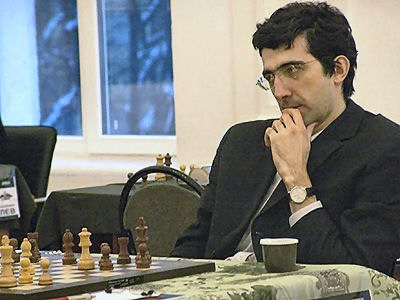 Vladimir Kramnik Vladimir Kramnik - Peter Leko Match for the World Title, Round 14 Brissago, 18 October 2004 Closed Caro-Kann Game: Tal Opening (Caro-Kann Defense) 1.e4 c6 2.d4 d5 3.e5 Bf5 4.h4 h6 5.g4 Bd7 6.Nd2
6...c5
7.dxc5 e6
8.Nb3 Bxc5 9.Nxc5 Qa5+ 10.c3 Qxc5 11.Nf3!?
11...Ne7
12.Bd3
12...Nbc6
13.Be3 Qa5 14.Qd2
14...Ng6 15.Bd4 Nxd4
16.cxd4 Qxd2+?!
17.Kxd2 Nf4 18.Rac1
18...h5 !""""""""# $t+ +l+ T% $Oo+v+oO % $ + +o+ +% $+ +oP +o% $ + P MpP% $+ +b+n+ % $pP K P +% $+ R + +r% /(((((((() WHITE: Vladimir Kramnik Position after 18...h6h5 19.Rhg1!
19...Bc6 20.gxh5 Nxh5 21.b4
21...a6 22.a4 Kd8
23.Ng5 Be8 24.b5
24...Nf4 25.b6 Nxd3
26.Kxd3 Rc8
27.Rxc8+ Kxc8 28.Rc1+ Bc6
29.Nxf7 Rxh4 30.Nd6+ Kd8
31.Rg1 Rh3+ 32.Ke2 Ra3
33.Rxg7 Rxa4 34.f4?!
34...Ra2+?
!""""""""# $ + L + +% $+o+ + R % $oPvMo+ +% $+ +oP + % $ + P P +% $+ + + + % $t+ +k+ +% $+ + + + % /(((((((() WHITE: Vladimir Kramnik Position after 34...Ra4a2+ 35.Kf3!
35...Ra3+ 36.Kg4 Rd3 37.f5 Rxd4+ 38.Kg5 exf5
39.Kf6 Rg4 40.Rc7 Rh4 41.Nf7+ 1-0
|
| Printer Friendly | Permalink | | Top |
| Jack Rabbit
|
Sat Apr-24-10 02:13 AM Response to Reply #5 |
| 10. Svidler - Topalov, FIDE World Championship Tournament, Round 5, San Luís, 2005 |
|
While my staff I personally feel that it is sufficient to name only the champions whose title is pased from Steinitz, there are two sides to this story.
With the knock tournaments recorgnized by the public at large for the joke it was, and serious movement toward a reunification of the world title, FIDE president Kirsan Ilyumzhinkov abandoned the knock out format in 2005 and organized a strong tournament among eight players to determine the new world champion. Vladimir Kramnik, who had defeated Kasparov in a match held in London in Ocotber 2000 to take charge of what FIDE condescendingly called the "Classical" world title, was invited, but had to decline due to having scheduled back surgery. Also invited was Rustam Kasidzhanov of Uzbekistan, another excellent but not great player who had won the most recent knock out tournament, making him Kirsan's idea of a world champion. The tournament was held in San Luís, Argentina in September and October 2005. It was won handily by Bulgarian grandmaster Veselin Topalov. The other competitors in addition to Kasimdzhanov were Anand, Peter Svidler, Alexander Morozevich, Leko, Mickey Adams and Judit Polgar, who became the first and so far only woman to compete for the world chess championship In light of the facts that Topalov had won the title in a strong tournament and that the classical champion's health would not allow him to compete, it seemed that Topalov actually a legitimate claim on the title. We therefore present one of Topalov's victories from San Luís.  Veselin Topalov Peter Svidler - Veselin Topalov FIDE World Championship Tournament, Round 5 San Luís, Argentina, 2 October 2005 Open Sicilian Game: Najdorf Defense 1.e4 c5 2.Nf3 d6 3.d4 cxd4 4.Nxd4 Nf6 5.Nc3 a6 6.Be3 Ng4 7.Bg5 h6 8.Bh4 g5 9.Bg3 Bg7 10.h3
10...Ne5
11.Nf5
11...Bxf5 12.exf5 Nbc6
13.Nd5 e6 14.Ne3 Qa5+!?
15.c3
15...Nf3+!?
16.Qxf3! Bxc3+ 17.Kd1 Qa4+ 18.Nc2!?
!""""""""# $t+ +l+ T% $+o+ +o+ % $o+mOo+ O% $+ + +pO % $w+ + + +% $+ V +qBp% $pPn+ Pp+% $R +k+b+r% /(((((((() WHITE: Peter Svidler Position after 18.Ne3c2 18...Bxb2!
19.fxe6
19...fxe6 20.Qb3
20...Qxb3 21.axb3 Bxa1 22.Nxa1 Ke7
23.Bd3 Rac8
24.Re1 Nd4
25.f3
!""""""""# $ +t+ + T% $+o+ L + % $o+ Oo+ O% $+ + + O % $ + M + +% $+b+b+pBp% $ + + +p+% $N +kR + % /(((((((() WHITE: Peter Svidler Position after 25.f2f3 25...Rc3! 26.Kd2 Rhc8 27.Rb1!?
27...R3c5 28.b4 Rd5 29.Bf2 Kd7
30.Be3 Nf5!?
!""""""""# $ +t+ + +% $+o+l+ + % $o+ Oo+ O% $+ + +mO % $ P + + +% $+ +bBp+p% $ + K +p+% $Nr+ + + % /(((((((() WHITE: Peter Svidler Position after 30...Nd4f5 31.Bf2!
31...Nh4
32.Bxh4 gxh4 33.Nc2 h5
34.Re1
34...Rg8 35.Kc3?!
35...a5!?
36.Bc4?
!""""""""# $ + + +t+% $+o+l+ + % $ + Oo+ +% $O +t+ +o% $ Pb+ + O% $+ K +p+p% $ +n+ +p+% $+ + R + % /(((((((() WHITE: Peter Svidler Position after 36.Be3c4 36...Rc8!
37.Ne3 Rb5 38.Kd3
38...Rxb4 39.Bxe6+
39...Kxe6 40.Nc2+ Kd5 41.Nxb4+ axb4 42.Re7
42...b5 43.Rh7
43...Rc3+ 44.Kd2 Rc4 0-1
|
| Printer Friendly | Permalink | | Top |
| Jack Rabbit
|
Sat Apr-24-10 02:18 AM Response to Reply #5 |
| 11. Kramnik - Anand, Round 5, Bonn, 2008 |
|
Edited on Sat Apr-24-10 02:20 AM by Jack Rabbit
In 2006, Kramnik, rejuvenated after his back surgery, defeated Topalov in a match intended to reunify the title of world champion.
In 2007, FIDE held another tournament to determine the world champion, this time in Mexico City. The tournament was won by Vishy Anand. Anand then defended his title against Kramnik in a match in Bonn, Germany, the following year. 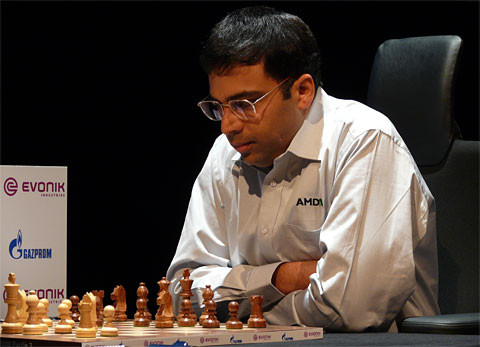 Vishy Anand Vladimir Kramnik - Vishy Anand Match for the World Title, Round 5 Bonn, 20 October 2008 Semi-Slav Queen's Gambit: Meran Defense (Reynolds Opening) 1.d4 d5 2.c4 c6 3.Nf3 Nf6 4.Nc3 e6 5.e3 Nbd7 6.Bd3 dxc4 7.Bxc4 b5 8.Bd3 a6 9.e4 c5 10.e5 cxd4 11.Nxb5 axb5 12.exf6 gxf6 13.0-0 Qb6 14.Qe2 Bb7 15.Bxb5
15...Rg8!?
16.Bf4
16...Bd6 17.Bg3!?
17...f5!?
18.Rfc1 f4 19.Bh4 Be7?!
20.a4!
20...Bxh4 21.Nxh4 Ke7 22.Ra3
22...Rac8 23.Rxc8!?
23...Rxc8 24.Ra1
24...Qc5 25.Qg4 Qe5
26.Nf3 Qf6
27.Re1 Rc5 28.b4
28...Rc3!?
!""""""""# $ + + + +% $+v+mLo+o% $ + +oW +% $+v+ + + % $pP O Oq+% $+ T +n+ % $ + + PpP% $+ + R K % /(((((((() WHITE: Vladimir Kramnik Position after 28...Rc5c3 29.Nxd4?
29...Qxd4 30.Rd1 Nf6!
31.Rxd4
31...Nxg4 32.Rd7+ Kf6 33.Rxb7
33...Rc1+ 34.Bf1 !""""""""# $ + + + +% $+r+ +o+o% $ + +oL +% $+ + + + % $pP + O +% $+ + M + % $ + + PpP% $+ T +bK % /(((((((() WHITE: Vladimir Kramnik Position after 34.Bc4f1 34...Ne3!!
35.fxe3 fxe3! 0-1
|
| Printer Friendly | Permalink | | Top |
| Jack Rabbit
|
Sat Apr-24-10 12:24 PM Response to Original message |
| 12. Update (Saturday): Topalov takes first game |
 Bulgarian grandmaster Veselin Topalov defeated reigning world champion Vishy Anand of India in the first round of their title match today in the Bulgarian capital of Sofia. Topalov, playing White, opened with his Queen's pawn and Anand defended with a Grünfeld Defense. The game lasted just 30 moves. |
| Printer Friendly | Permalink | | Top |
| Jack Rabbit
|
Sun Apr-25-10 01:51 PM Response to Original message |
| 13. Update (Sunday): Vishy bounces back, takes Game 2 |
 Reigning world chess champion Vishy Anand of India, the first Asian ever to hold the title, bounced back from a crushing defeat in the first round to take down Bulgarian GM Veselin Topalov in 43 moves today in the second game of the world championship match now being held in the Bulgarian capital of Sofia. Anand, playing White, opened with his d-pawn and the game spun into a Catalan Opening, basically a Queen's Gambit where White develops his King's Bishop on the flank. Anand allowed Topalov to keep the gambit pawn for some time, with Black being a pawn to the good until the 28th move. White was able to minimize Black's advantage after the 16th move when an exchange of Queens opened up the queenside and White was able to activate his Rooks. After leveling the pawn count, Anand took advantage of a series of inferior moves by Topalov to get the upper hand and win a Rook-and-pawn ending. Tomorrow is a rest day with the match resuming at 3 pm Eastern European Standard Time (5 am PST) with the game broadcast live from the official match website. |
| Printer Friendly | Permalink | | Top |
| Jack Rabbit
|
Tue Apr-27-10 05:21 PM Response to Original message |
| 14. Updates (Tuesday) |
|
Edited on Tue Apr-27-10 05:22 PM by Jack Rabbit
Vishy, Topa Draw in Round 3; Match still Knotted
 Reinging world champion Vishy Anand of India, playing Black, drew the third game of his title match with Bulgarian grandmaster Veselin Topalov in an uneventful game today in Sofia, Bulgaria. The scheduled 12-game match is currently deadlocked at 1½ points apiece, with each player winning one of the first two games. Round 4 will take place tomorrow at 3 pm Eastern European Standard Time (5 am PST) and will be broadcast on the official tournament website. New Leaders in Subic Bay after Ni Hua Beats So  Grandmaster Ni Hua of China defeated 16-year-old Filipino GM Wesly So today in the general group of the Ninth annual Asian Championships in Subic Bay, the Philippines, to push So out of first place and replace him with a quartet of players. The new leaders are Ni, his compatriots Li Chao and reigning Chinese champion Ding Liren, and Indian grandmaster and forer world junior champion Abhijeet Gupta, all with 5½ points out of seven rounds. Young Mr. So, who entered today's round alone in first place, falls to a four-way tie for fifth with Chinese GM Zhao Jinchao, Yu Ruiyuan, an untitled player for China, and grandmaster Krishnan Sasikiran, India's second-rank player to reining world champion Vishy Anand. In the women's group, Chinese WGM Wang Yu and Iranian WGM Atousa Pourkashiyan lead the pack with 6 points each. Ding Yixin, a WFM from China, is in third place with 5 points. The tournaments directors at the technical meeting before the start of the tournament reduced the number of game from eleven to nin for both the general group, which has 90 participants, and the women's group, which has 24. Third Leg of Women's Grand Prix in Progress The third leg of the FIDE Women's Grand Prix began Monday in Nalchik, the capital of the Kabardino-Balkar Republic in Russia. The first two rounds have been full of exciting chess and a couple of major upsets. Yesterday, in Round 1, Betul Cemre Yildiz of Turkey, one of the lower rated players in the Grand Prix, defeated Chinese grandmaster Zhao Xue, the leader of the GP after the first two legs, in 64 moves. In today's second round, Mongolia's Batkhuyag Munguntuul took down the world second highest rated woman, grandmaster Koneru Humpy of India, when she delivered checkmate on the fortieth move. As of now, four players are tied for first with a point and a half each: Ms. Yildiz, Tatiana Kosintseva of Russia, Georgian GM Nana Dzagnidze and former world women's champion Zhu Chen, a native of China who since 2006 has played for Qatar, where she lives with her husband, grandmaster Mohammed al-Modiahki. |
| Printer Friendly | Permalink | | Top |
| Jack Rabbit
|
Wed Apr-28-10 10:39 AM Response to Original message |
| 15. Update (Wednesday): Anand Crushes Topalov in Game 4, Takes Lead |
|
Edited on Wed Apr-28-10 10:44 AM by Jack Rabbit
 Reigning world champion Vishy Anand dealt challenger Veselin Topalov a crushing and brilliant tactical defeat in 32 moves just minutes ago in the fourth round of their world title match in Sofia, Bulgaria. Anand leads for the first time in the match, where the score now stands at 2½-1½. 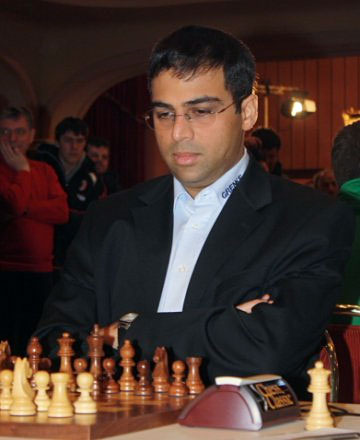 Vishy Anand Tomorrow is a day off. The match resumes Friday with Topalov playing White. |
| Printer Friendly | Permalink | | Top |
| Jack Rabbit
|
Fri Apr-30-10 04:38 PM Response to Original message |
| 16. Updates (Firday) |
|
Edited on Fri Apr-30-10 04:41 PM by Jack Rabbit
Game 5 drawn; Vishy Leads Title Match, 3-2
 Reigning world champion Vishy Anand and challenger Veselin Topalov played to a draw today in the fifth game of their title match in the Bulgarian capital of Sofia. The champion leads the scheduled 12-round match with 3 points to Topalov's 2. The sixth game takes place tomorrow with live coverage at the official website beginning at 3 pm Eastern European Summer Time (5 am PDT). Ni Hua, Atousa Win Asian Continental Championships  Chinese grandmaster Ni Hua won the general group of the Asian Continental Championships yesterday in Subic Bay, the Philippines, with 7 points out of a possible 9 while WGM Atousa Pourkashiyan of Iran won the women's group with the same score. Mr. Ni took a share of the lead in round 7 when he defeated 16-year-old Filipino GM Wesley So, who had held the lead from the early going. Ni then defeated his compatriot Li Chao in the eighth round to take sole possession of first place. Young Mr. So, former world junior champion Abhijeet Gupta of India, Chinese GM Zhou Jianchao and top seed Le Quang Liem of Vietnam tied for second at 6½ points each. Ms. Pourkashiyan came from behind to overtake Chinese international master Wang Yu in the late rounds after losing to Ms. Wang in the second round. Ms. Pourkashiyan's key victories were her sixth round win over WFM Ding Yixin of China, who finished tied for second with Ms. Wang with 6½ points, and a stunning tactical tour-de-force from the Black side of the board against tournament top seed Ju Wenjun in just 22 moves in round 7. Tanya Kosintseva Leads Women's GP in Nalchik after Five  Russian grandmaster Tatiana Kosintseva leads the field in the third leg of the 2009-10 FIDE Women's Grand Prix by a widening margin with 4½ points from the first five rounds in Nalchik, the capital of the Russian Republic of Kabardino-Balkar. Four players are currently tied for second with 3 points each, two of whom Tatiana Anatolyevna has alredy defeated. They are 16-year-old Chinese GM Hou Yifan (Tatiana Anatolyevna's first round victim), Nana Dzagnidze of Georgia (who fell to Tatiana Anatolyevna earlier today), Russian WGM Baira Kovanova and the reigning European women's champion, Pia Cramling of Sweden. |
| Printer Friendly | Permalink | | Top |
| subsuelo
|
Sat May-01-10 07:40 AM Response to Reply #16 |
| 17. I love how they played the same first 15 (or so) moves from the previous game |
|
And with Anand breaking out of it first. He then apparently got up to get a drink of water, after sensing that Topalov's plan had been foiled...
|
| Printer Friendly | Permalink | | Top |
| DU
AdBot (1000+ posts) |
Fri Apr 26th 2024, 11:32 AM Response to Original message |
| Advertisements [?] |
| Top |
| Home » Discuss » Topic Forums » Sports |
|
Powered by DCForum+ Version 1.1 Copyright 1997-2002 DCScripts.com
Software has been extensively modified by the DU administrators
Important Notices: By participating on this discussion board, visitors agree to abide by the rules outlined on our Rules page. Messages posted on the Democratic Underground Discussion Forums are the opinions of the individuals who post them, and do not necessarily represent the opinions of Democratic Underground, LLC.
Home | Discussion Forums | Journals | Store | Donate
About DU | Contact Us | Privacy Policy
Got a message for Democratic Underground? Click here to send us a message.
© 2001 - 2011 Democratic Underground, LLC